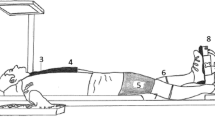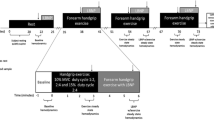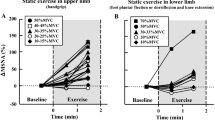Summary
A one second square wave decrease or increase in perfusion pressure induced active vasodilatation in the vascular bed of gracilis muscle. The peak time of this response is 4.42±0.32 and 3.52±0.25 sec respectively and its duration is 24.8±3.9 and 24.5±2.9 sec respectively.
The dilator response (that first value always refers to the pressure decrease and the second for the pressure increase) is:
-
a)
Directly proportional to the amplitude of perfusion pressure change up to an amplitude of 73.9±2.3 and 78.4±1.8 mm Hg respectively. The vascular resistance decreases to 29.6±1.7 and 32.2±1.8% respectively of the resting value. Further increase of the amplitude show no statistically significant influence.
-
b)
Dependent on the perfusion pressure. Within the range of perfusion pressures of 78.6±1.9 to 113.6±2.3 mm Hg and 77.5±2.7 to 112.3±4.2 mm Hg respectively a maximal response occurs.
-
c)
The duration of the vasodilatation is directly proportional to the amplitude of the perfusion pressure change. From the lowest to the highest amplitudes the duration of the response was prolonged from 15.8±2.2 to 30.3±5.3 sec and from 17.5±1.6 to 28.1±4.3 sec respectively.
The agreement in all of the parameters indicates that the mechanism of this vasodilatation is independent of the polarity of the pressure change. Analysis of the results confirmed that the vascular response is based on a unidirectional sensitivity of the system of local control of blood flow to the ascending component of the perfusion pressure change. It is proposed that two types of myogenic vascular response in skeletal muscle should be differentiated:
1. the Bayliss' response to change in the perfusion pressure level, and 2. the vasodilatory response to the ascending component of this pressure change.
Similar content being viewed by others
References
Ardill, B. L., Blatnagar, V. M., Fentem, P. H.: Reduction in the vasoconstriction produced by sympathetic adrenergic nerves during reactive hyperaemia. Cardiovasc. Res.1, 327–334 (1967).
Bayliss, W. M.: On the local reaction of the arterial wall to change of internal pressure. J. Physiol. (Lond.)28, 220–231 (1902).
Burnstock, G., Prosser, C. L.: Responses of smooth muscles to quick stretch; relation of stretch to conduction. Amer. J. Physiol.198, 921–925 (1960).
Clynes, M.: The non-linear biological dynamics of unidirectional rate sensitivity illustrated by analog computer analysis, pupillary reflex to light and sound, and heart rate behaviour. Ann. N.Y. Acad. Sci.98, 806–845 (1962).
Condorelli, L., Strane, A., Filocame, G., Dagianti, A., Bartolo, M.: Baric peripheric vascular reflex with local effect. Cardiologia (Basel)39, 259–297 (1961).
Folkow, B.: Intravascular pressure as a factor regulating the tone of small vessels. Acta physiol. scand.17, 289–310 (1949).
—: A study of the factors influencing the tone of denervated blood vessels perfused at various pressures. Acta physiol. scand.27, 99–117 (1952a).
—: A critical study of some methods used in investigations on the blood circulation. Acta physiol. scand.27, 118–129 (1952b).
—: Transmural pressure and vascular tone: Some aspects of an old controversy. Arch. int. Pharmacodyn.139, 445–468 (1962).
— Löfving, D.: The distensibility of the systemic resistance blood vessels. Acta physiol. scand.38, 37–52 (1956).
Gerová, M., Gero, J.: The sympathetic control of consecutive parts of the vascular bed in the limb. In: Circulation in skeletal muscle. O. Hudlická (Ed.), pp. 53–67. Oxford: Pergamon Press 1968.
Goldschmidt, H., Lindgren, P.: An electronic interval recorder for measuring peripheral blood flow and heart rate. J. appl. Physiol.17, 169–171 (1962).
Green, D. H., Lewis, R. N., Nickerson, N. D., Heller, A. L.: Blood flow, peripheral resistance and vascular tone, with observations on the relationship between blood flow and cutaneous temperature. Amer. J. Physiol.141, 518–536 (1944).
— Rapela, C. E.: Blood flow in passive vascular beds. Circulat. Res.15, Suppl.1. 11–16 (1964).
Haddy, F. J., Scott, J. B.: Effects of flow rate, venous pressure, metabolites, and oxygen upon resistance to blood flow through the dog forelimb. Circulat. Res.15, Suppl. 1, 49–50 (1964).
Hanson, K. M.: Discussion: Autoregulation in the hindlimb. Circulat. Res.15, Suppl. 1, 25–29 (1964).
Johnson, P. C.: Autoregulatory responses of cat mesenteric arterioles measured in vivo. Circulat. Res.22, 199–212 (1968).
Jones, R. D., Berne, R. M.: Active vasodilation in response to increased transmural pressures in skeletal muscle. Fed. Proc.21, 107 (1962).
——: Intrinsic regulation of skeletal muscle blood flow. Circulat. Res.14, 126–138 (1964).
Kontos, H. A., Mauck, H. P., Patterson, J. L.: Mechanism of reactive hyperemia in the limbs of anesthetized dogs. Amer. J. Physiol.209, 1106–1114 (1965).
Remensnyder, J. P., Mitchel, J. H., Sarnoff, S. J.: Functional sympatholysis during muscular activity. Circulat. Res.11, 370–380 (1962).
Remington, J. W., Alexander, R. S.: Relation of tissue extensibility to smooth muscle tone. Amer. J. Physiol.185, 302–308 (1956).
Renkin, E. M.: Techniques of vascular perfusion. In: Physical techniques in biological research W. L. Nastuk (Ed.). New York-London: Academic Press 1962.
Rowlands, D. J., Donald, D. E.: Sympathetic vasoconstrictive responses during exercise— or drug—induced vasodilatation. Circulat. Res.23, 45–60 (1968).
Somlyo, A. P., Somlyo, A. V.: Vascular smooth muscle. 1. Normal structure, pathology, biochemistry, and biophysics. Pharmacol. Rev.20, 197–272 (1968).
Stainsby, W. M.: Autoregulation in skeletal muscle. Circulat. Res.15, Suppl. 1, 39–45 (1964).
— Renkin, E. M.: Autoregulation of blood flow in resting skeletal muscle. Amer. J. Physiol.201, 117–122 (1961).
Zsoter, T.: The effect of intravascular pressure changes on blood flow. Canad. J. Biochem. Physiol.39, 763–769 (1961).
Author information
Authors and Affiliations
Rights and permissions
About this article
Cite this article
Smieško, V. Unidirectional rate sensitivity component in local control of vascular tone. Pflugers Arch. 327, 324–336 (1971). https://doi.org/10.1007/BF00588451
Received:
Issue Date:
DOI: https://doi.org/10.1007/BF00588451
Key-Words
- Vasodilatation in Response to Brief Perfusion Pressure Change
- Unidirectional Vascular Sensitivity
- Two Types of Myogenic Vascular Response




